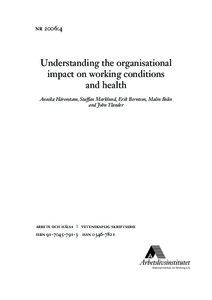Understanding the organisational impact on working conditions and health
"It has long been known that organisational conditions affect working conditions and occupational health. However, the transfer of knowledge about risk factors from traditional occupational health research into prevention requires insight into the organisational context. Moreover, there is a br...
| Main Authors: | , , , , |
|---|---|
| Institution: | ETUI-European Trade Union Institute |
| Format: | TEXT |
| Language: | English |
| Published: |
Stockholm
2006
NIWL |
| Subjects: | |
| Online Access: | https://www.labourline.org/KENTIKA-19138316124919565989-understanding-the-organisation.htm |
| Summary: | "It has long been known that organisational conditions affect working conditions and occupational health. However, the transfer of knowledge about risk factors from traditional occupational health research into prevention requires insight into the organisational context. Moreover, there is a breach between organisational research and health research in terms of concepts, theories, and methodologies, and there is a lack of useful theories and models for how organisational conditions are linked to working conditions and health. One argument for the development of concepts, theoretical models, and methodological tools for studies of the organisational impact on psychosocial working conditions and health is that working life is changing. Another argument is that organisation at the meso level and work practices at the worker level are greatly interdependent. Thus, when the organisation of work changes, our understanding of how organisations, work practices, and working conditions affect health must be scrutinised. We cannot take it for granted that traditional theories are still valid.
This report discusses some suggestions for the design and methodology of empirical studies aimed at bridging the gap between research on organisations and research on individual working conditions and health. This approach in work-life research can be described as organisation-oriented work and health research. Our main aim is to discuss the conceptual, theoretical, analytical, and empirical difficulties and options involved with such an approach. Using the examples of a number of research projects with different specific questions and different empirical designs, we attempt to detect some of the most common stumbling blocks and to find some pragmatic solutions to the problems which arise in this type of research. We discuss some specific problems with the integration of organisational studies and health research, and draw conclusions about the application of such research results to prevention and intervention.
There are several conceptual and theoretical challenges associated with the design of studies that try to integrate organisational-level data with working conditions and health data at the individual level. Firstly, there is a wide gap between organisational research and occupational health research in the use of theoretical concepts, in the choice of focal units of analysis, and in data treatment. Secondly, in relation to intervention and prevention, not all factors that affect working conditions and health may be equally easy to change, and there is thus a need to focus on factors that the employer and the representatives of the workers may be willing to adjust. Finally, although powerful statistical techniques such as multilevel analysis are available to link organisational and micro-level data, understanding of the causal mechanisms becomes even more complicated when individual and organisational conditions are to be interpreted. Thus, there is a need for improved analytical tools in order to understand such complex associations. There are also a number of empirical issues involved in the linking of organisations and individuals. One is the determination of what aspects at the organisational level are important and another is how such organisational aspects can be measured and assessed. It is also important to decide what level within organisations is most relevant to a specific study. Another problem that is particularly important, as many contemporary organisations are volatile and have diffuse boundaries, is how organisations should be defined and how individual employees should be linked to a specific part of an organisation. This means, for example, that formal and informal power and responsibility structures for coping with the psychosocial work environment are very complex in contemporary organisations. Some of our most important observations have arisen as a consequence of an attempt to empirically explore contemporary organisations. One conclusion is that selection mechanisms should be taken into account, as many individuals move between occupational conditions. Additionally, these changes may be very different for different groups, depending on individual and organisational conditions. As a consequence of this insight, workers and managers cannot be seen as passive victims of conditions at the workplace or in the organisation, but must be viewed as elective and active humans. This is the case even when there are strong restrictions on their room for manoeuvre." |
|---|---|
| Physical Description: | 81 p. Digital |

